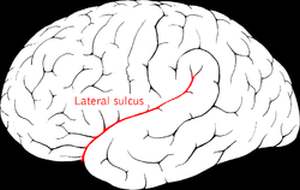

MedFriendly®


Sulcus
Sulcus has several possible definitions in the field of
medicine. In the most broad sense, it is any long,
narrow groove or slight depression. It is often used to
refer to one of the shallow grooves, wrinkles, or
depressions on the surface of an organ, such as the
brain. Sulci (the plural form of sulcus) helps form the
boundaries of several irregular ridges on the brain
known as convolutions, and rounded elevations on the
brain known as gyri (plural of gyrus). In dentistry, a
sulcus is a depression or groove on the surface of a
tooth or in the mouth.
The lateral sulcus of the brain.
FEATURED BOOK: Neuroanatomy through Clinical Cases
A sulcus is different from a fissure, which is a deep space, groove, or slit on the surface
of an organ. Sometimes, however, sulcus and fissure are used interchangeably to refer
to the same thing in the study of the structure of the human body. A good example is the
most famous sulcus in the brain, the central sulcus, which used to be known as the
fissure of Rolando or the Rolandic fissure. The central sulcus separates the parietal lobe
from the frontal lobe of the brain. The parietal lobe is the middle area of the top part of the
brain (on both sides) and is responsible for integrating sensory information to form
perceptions and spatial sense. Variations on the word sulcus include sulcal, sulcate,
sulciform, and sulculus. Sulcal means relating to a sulcus. Sulcate means to be grooved.
Sulciform means to have the shape of a groove or a sulcus. A sulculus is a small sulcus.
Sulcus is Latin for "ditch or furrow." A furrow is a deep wrinkle.
"Where Medical Information is Easy to Understand"™















